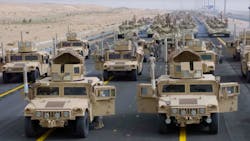Army could save lives with machine autonomy and unmanned ground vehicle (UGV) to protect important convoys
SANTA MONICA, Calif. – U.S. Army convoys could be made safer for soldiers by implementing unmanned ground vehicle (UGV) technology to reduce the number of service members needed to operate the vehicles, according to a new study from the RAND Corp. in Santa Monica, Calif. EurekAlert reports. Continue reading original article
The Military & Aerospace Electronics take:
24 Feb. 2020 -- RAND experts examined three different autonomous vehicle concepts: the fully autonomous employment concept, where all the vehicles are unmanned; the partially unmanned employment concept, featuring a lead truck with soldiers followed by unmanned vehicles in a convoy; and minimally manned, a "bridging" concept featuring a soldier in the driver's seat of each of the follower trucks to monitor the automated system and driving environment.
Minimally manned Army convoys could enhance safety by putting 28 percent fewer soldiers at risk compared to current practices. A partially unmanned convoy would put 37 percent fewer soldiers at risk, and a fully autonomous convoy would put 78 percent fewer soldiers at risk.
The machine autonomy technology to make an Army convoy fully autonomous doesn't exist yet. Part of the challenge for the Army is that current automated technology is still limited and has mainly been tested in settings with well-manicured infrastructure, including standardized road markings and signs.
Related: Robotic technologies for the future land warrior
Related: Networking vehicles on the future battlefield
John Keller, chief editor
Military & Aerospace Electronics

